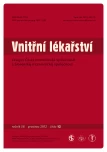Toxic hepatitis induced by Polygonum multiflorum
Authors:
A. Baňárová; T. Koller; J. Payer
Authors‘ workplace:
V. interná klinika Lekárskej fakulty UK a UN Bratislava, Slovenská republika, prednosta prof. MUDr. Juraj Payer, CSc.
Published in:
Vnitř Lék 2012; 58(12): 958-962
Category:
Case Report
Overview
Toxic liver injury is a common cause of acute hepatitis. Here we report a case of 33-year old female with toxic hepatitis caused by unusual agent – extract of chinese plant Polygonum multiflorum. The patient presented with clinical signs of nausea and icterus and laboratory signs of hepatocellular damage following 2 months of readministration of Polygonum mulltiflorum pills. All other causes of hepatocellular damage were excluded. The causality between hepatocellular damage and Polygonum multiflorum ingestion was supported by early recovery after discontinuation, by international scoring system of causality between drug and hepatotoxicity as well as by similarities with other reports from the literature. Considering the growing popularity of herbal products as nutrition supplements we appeal to caution in using these preparations.
Key words:
toxic hepatitis – Polygonum multiflorum
Sources
1. Estes JD, Stolpman D, Olyaei A et al. High prevalence of potentially hepatotoxic herbal supplement use in patients with fulminant hepatic failure. Arch Surg 2003; 138; 852–858.
2. Stedman C. Herbal hepatotoxicity. Semin Liver Dis 2002; 22: 195–206.
3. Kyoung AJ, Hyun JM, Seung SY et al. Drug-Induced Liver Injury: Twenty Five Cases of Acute Hepatitis Following Ingestion of Polygonum multiflorum Thunb. Gut and Liver 2011; 5/4: 493–499.
4. Furukawa M, Kasajima S, Nakamura Y et al. Toxic hepatitis induces by show-wu-pian, a chinese herbal preparation. Intern Med 2010; 49: 1537–1540.
5. But PP, Tomlinson B, Lee KL et al. Hepatitis related to the Chinese medicine Shou-wu-pian manufactured from Polygonum multiflorum. Vet Hum Toxicol 1996; 38: 280–282.
6. Mazzanti G, Battinelli L, Daniele C et al. New case of acute hepatitis following the consumption of ShouWuPian, a Chinese herbal product derived from Polygonum multiflorum. Ann Intern Med 2004; 140: W30.
7. Panis B, Wong DR, Hooymans PM et al. Recurrent toxic hepatitis in a Caucasian girl related to the use of Shou-Wu-Pian, a Chinese herbal preparation. J Pediatr Gastroenterol Nutr 2005; 41: 256–258.
8. Park GJ, Mann SP, Ngu MC et al. Acute hepatitis induced by Shou-Wu-Pian, a herbal product derived from Polygonum multiflorum. J Gastroenterol 2001; 16: 115–117.
9. Cárdenas A, Restrepo JC, Sierra F et al. Acute hepatitis due to shen-min: a herbal product derived from Polygonum multiflorum. J Clin Gastroenterol 2006; 40: 629–632.
10. Liang Z, Chen H, Yu Z et al. Comparison of raw and processed Radix Polygoni Multiflori (Heshouwu) by high performance liquid chromatography and mass spectrometry. Chin Med 2010; 12: 29.
11. Wu X, Chen X, Huang Q et al. Toxicity of raw and processed roots of Polygonum multiflorum. Fitoterapia 2012; 83: 469–475.
12. Yu J, Xie J, Mao XJ et al. Hepatoxicity of major constituents and extractions of Radix Polygoni Multiflori and Radix Polygoni Multiflori Praeparata. J Ethnopharmacol 2011; 137: 1291–1299.
13. Yu C, Chai X, Yu L et al. Identification of novel pregnane X receptor activators from traditional Chinese medicines. J Ethnopharmacol 2010; 136: 137–143.
14. Maddrey WC. Drug-Induced Hepatotoxicity. J Clin Gastroenterol 2005; 39: 83–89.
15. Kaplowitz N. Drug-Induced Liver Injury. Clin Infect Dis 2004; 38: S44–S48.
16. Andrade RJ, Robles M, Fernández-Castaner A et al. Assessment of drug-induced hepatotoxicity in clinical practice: A challenge for gastroenterologists. World J Gastroenterol 2007; 13: 329–340.
17. Yantorno SE, Kremers WK, Ruf AE et al. MELD is superior to King’s college and Clichy’s criteria to assess prognosis in fulminant hepatic failure. Liver Transpl 2007; 13: 822–828.
Labels
Diabetology Endocrinology Internal medicineArticle was published in
Internal Medicine

2012 Issue 12
Most read in this issue
- Arterial hypertension in gravidity – a risk factor for cardiovascular diseases
- Current opinions on gout, its diagnosis and treatment
- Current guidelines on the care of tunelized vascular catheters in patients on home parenteral nutrition
- Is antiplatelet therapy always effective?
